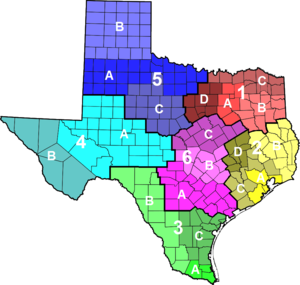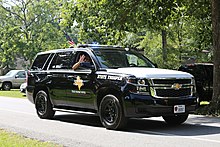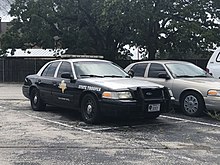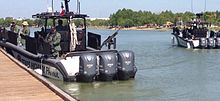Texas Highway Patrol
They quickly developed an international reputation for their exploits and perceived fearlessness (Mexican soldiers nicknamed them "Texas Devils" for their scouting and fighting abilities).
From 1823 to 1845, they were a territorial force made up of volunteers charged with fighting Native Americans, guarding the Mexican border, and capturing thieves, murderers, and other criminals, occasionally by controversial methods.
GPS lets regional dispatch centers identify a patrol unit's exact location, and in-car computers (Mobile Data Terminals) allow troopers to receive knowledge of a person's background before ever approaching a vehicle.
These systems, mounted in the patrol car, allow traffic citations to be largely completed by scanning an offender's identification card into the Mobile Data Terminal.
Despite the size of the highway patrol and its unique name and function, however, many Texans refer to troopers simply as "DPS", referencing the THP's parent agency.
[5] Hands-on material covered includes weapons training, crash investigation, arrest and control tactics, pursuit driving, and intense physical readiness.
These duties may include responding to civilian calls for service, serving warrants, patrolling the U.S.-Mexico border, conducting investigations, and other responsibilities.
From 2014 to 2017, the Texas Highway Patrol participated in Operation Strong Safety, a program intended to increase law enforcement along the Texas-Mexico border.
The patrol's role in Operation Strong Safety (OSS) was to deploy large numbers of troopers to the border in order to add an increased deterrent to drug traffickers and human smugglers.
OSS was the successor to previous similar efforts, such as Operation Border Star, and was approved by the Texas Legislature with an $800 million price tag.
[11] Some experts also questioned the patrol's aggressive pursuit tactics, which often involve shooting out the tires of fleeing vehicles and performing roadblock techniques.
Controversy about the role of firearms in pursuits arose in October 2012 after a THP sharpshooter in a helicopter opened fire on a suspected drug smuggler, accidentally killing two illegal immigrants who were concealed within the vehicle.
[12] In 2015, the Dallas Morning News reported that the constant rotation of troopers from across the state to the border appeared to be responsible for a significant drop in DPS productivity elsewhere in Texas.
Hidalgo County, for example, tripled its DPS station from 20 to 60 permanently assigned troopers during Operation Border Star, the predecessor to OSS; this number has since risen to over 90.
[20] According to one media source, troopers assigned to Operation Lone Star have occasionally been required to work 14-hour shifts for as many as 15 days in a row.
[25][26][27] In May 2019, Texas Governor Greg Abbott ordered the deployment of dozens of Highway Patrol troopers to South Dallas in response to a sharp rise in crime there.
[31] Controversy stemming from the operation arose in August 2019 when two troopers assigned to patrol South Dallas fatally shot 27-year-old Schaston Hodge after a short pursuit.
Body-worn camera footage released by the Texas DPS in January 2020 showed Hodge aiming a pistol at the troopers before being shot 16 times.
[55] In 2013, Texas DPS officials announced that they would be switching to the Smith & Wesson M&P, 9-millimeter handgun as the standard-issue sidearm for troopers, due to higher round capacity over the SIG Sauer.
[citation needed] Less-lethal weapons issued to troopers includes expandable straight batons, oleoresin capsicum spray, and Tasers.
The decision was based on a trend of troopers being required to live hours away from their families in order to prevent their spouses from having to leave steady employment.
The Grapevine Slayings were the murders of two Texas Highway Patrolmen on April 1, 1934 by members of the Barrow Gang, popularly known as Bonnie and Clyde.
Murphy and Edward Bryan Wheeler, both stationed in Fort Worth, were on routine patrol on State Highway 114 in Grapevine when they noticed a car parked on intersecting Dove Road.
They were unaware that the car's occupants were Bonnie Parker, Clyde Barrow, and Henry Methvin, outlaws wanted in several states for a string of robberies, kidnappings, and murders - including those of multiple police officers - that began in 1932 and had brought the gang nationwide attention.
A passing motorist witnessed the shooting and flagged down another trooper, who arrived to find Wheeler dead and Murphy in critical condition.
[66] Although the Barrow Gang had enjoyed a romantic image among many Americans before the Grapevine shootings, their popularity waned rapidly in the wake of the killings.
Upon their arrival, the two deputies were met with gunfire from a high-powered rifle fired by Engleton, who was hiding in a ditch across the street from his mobile home.
Trooper Terry Wayne Miller arrived on scene, discovered the two bodies of the deputies, radioed for assistance, and was shot and killed before he was able to remove his seatbelt.
The two injured officers were saved by 56-year-old cattle rancher Wendell Munson who dodged bullets to assist them into his pickup truck before speeding off.
As more law enforcement officers converged on the scene of the crime, Jeremiah Engleton turned the stolen police handgun on himself and committed suicide.





